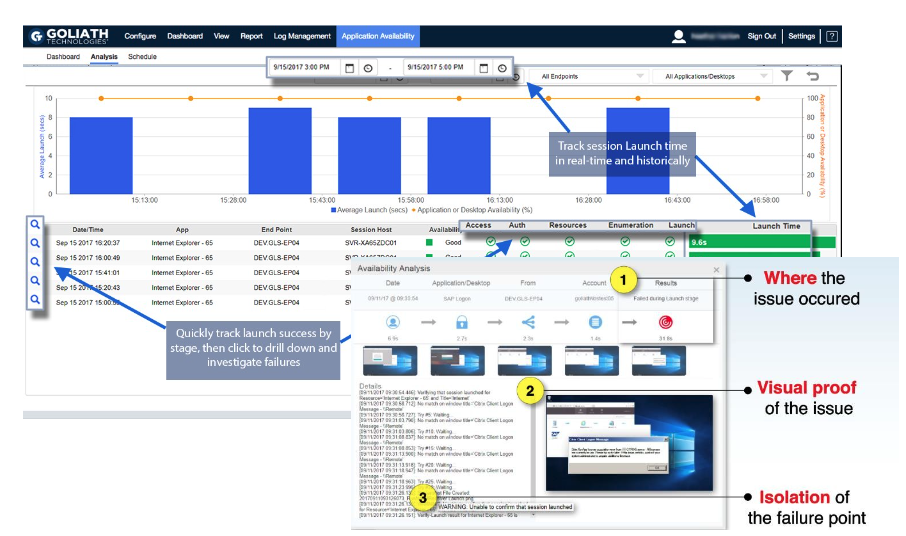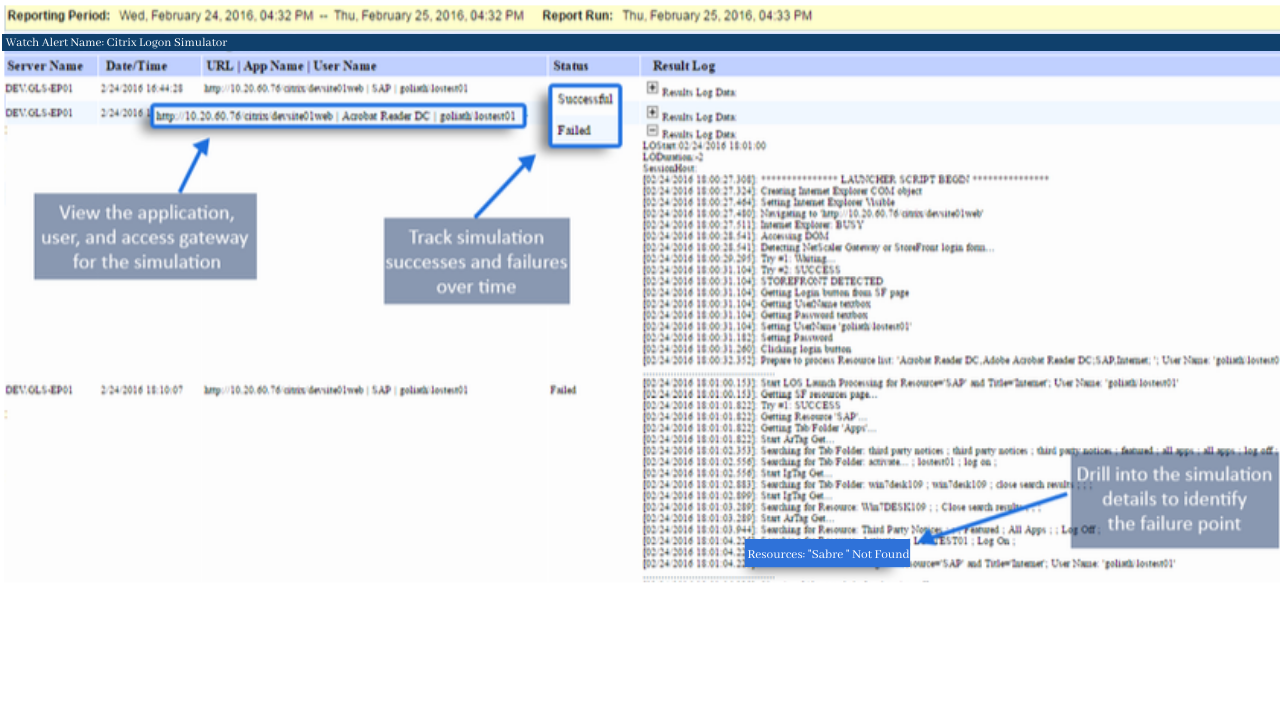How We Did IT
Top 5 Airline Uses Goliath’s Application Availability Testing as a Service with AWS to Prevent Citrix Failed Logons

Infrastructure
Citrix XenDesktop & Citrix XenApp; AWS; Sabre Technology
Challenge
Random outages of reservation application running on Citrix XenDesktop and Citrix XenApp was negatively impacting customer service.
The Goliath team received an inquiry from the Citrix engineering group at one of the top airlines in the world. The Citrix engineers were faced with four unique challenges:
- They needed a way to continuously test remote connectivity and availability of their Citrix VDI infrastructure and reservation system.
- They required the ability to be proactively alerted to issues before reservation specialists experienced an outage, negatively impacting customer service.
- Software could not be deployed on-premise within their IT infrastructure, so a cloud-based solution was required.
- They needed objective evidence in the form of reports, analytics, and even screenshots to prove success, failure, and, if a failure, root cause.
For context, this airline has approximately 2,000+ remote reservation specialists who take reservations and VIP support calls. They work from home and in small offices and, therefore, experience variable connection quality. This team depends on Citrix for delivery of key applications in order to perform their daily duties, and availability of those resources needs to be 24/7/365.
Solution
Goliath’s Application Testing as a Service with AWS Monitoring
Understanding the requirements, the Citrix engineers were introduced to Goliath’s Application Availability Testing as a Service using AWS. It enabled them to continually test availability of not only their reservation application but the entire Citrix XenApp and XenDesktop environment for all remote workers. The Goliath AWS Monitoring Solution is hosted in AWS and, therefore, doesn’t require any software on-premises. The onboarding process was easy. A configuration link was sent to them where they entered the following information:
- URL to connect to the Citrix environment
- The Citrix account credentials
- Application or desktop name to be tested
- Email address for receiving real-time alerts from the Application Availability Service
Upon saving the information, the Goliath’s Application Availability Testing as a Service was fully configured and ready to begin the process of confirming Citrix application availability in production.
As depicted below, Goliath’s Application Availability Testing as Service for Citrix XenApp and XenDesktop is configured to confirm application availability from two different points in the United States and one in Europe deployed on AWS instances in each region. Each was selected based on time zone and the largest clusters of remote employees. From each AWS instance, the Goliath Application Launcher initiates a real Citrix logon from the endpoint in AWS to the data center hosting Citrix. It logs on like a real user with all the same permission settings as in Active Directory. From the gateway through to the application and/or desktop launch, the application availability service tests each component of the delivery infrastructure, in concert, identical to an actual end user.
Image 1: Above is an illustration of their deployment across remote locations. To test for all remote users, Goliath’s App Launcher is launched from AWS instances located on the east and west coast of the U.S. and another in Europe. All launchers launch then to the centralized Citrix delivery infrastructure located on-premise in their data center.
Immediately after deploying the testing service, the Citrix team started seeing failed or slow Citrix logons in real time. For the first time, they had visibility into where Citrix availability issues were occurring around the globe with screenshot evidence (Image 2).
As issues were uncovered, alerts were sent from the Goliath’s Console for AWS Monitoring to the appropriate Citrix monitoring personnel. In addition to alerting, Citrix administrators were able to view the health of their environment from a live dashboard (Image 2) and address any issues before calls came into the help desk.
Image 2: In this case, failure occurred at the launch stage (1). The screenshot (2) proves that the application failed to launch and shows the root cause of the Citrix workflow and application launch failure resulted due to a licensing problem. Then by navigating to the “Details” or “Analytics” section (3), we can see that the launch failed at the point of verifying that Internet Explorer launched.
Beyond a real-time view into the health of the production availability of the reservation application, there was also a need for the Citrix team to be able to run AWS monitoring reports on Citrix’ end user logon success or failure rates. Management required that the application availability meet SLA requirements. Because Goliath confirmed Citrix and the reservation application availability in production, the reports could also serve as objective evidence of validation that uptime requirements were being met.
As depicted in Goliath’s Application Launcher Success and Failure Analysis Report below (Image 3), every detail is captured as the production logon sequence is completed and then is presented in the output of the report, providing the empirical evidence required to validate environment uptime and availability. The detail provided in the reports also helped to quickly identify patterns and trend over time where Citrix availability issues were occurring for remote users, thereby allowing technical teams to better collaborate across the organization and get issues resolved.
Image 3: Goliath offers historical data to identify trends around application availability and overall logon performance. This data can be viewed leveraging one of Goliath’s out-of-the box reports that can be shared via email, export (pdf, csv), or directly in the Goliath Console.
Results
Goliath’s Application Availability Testing as a Service with AWS Monitoring satisfied the needs and requirements of the major airline. The team was empowered with a service that could logon remotely from AWS locations and confirm in production that applications were available or alert to failures or slowness. It provided them with a live real-time dashboard and threshold-based alerts so they could be aware of issues before their users or business units were impacted. The AWS Monitoring service also enabled them to provide historical reports to management to substantiate that SLA’s were being met and to pinpoint and resolve issues discovered over time. The entire software is provided as a monthly service by Goliath leveraging AWS to host the software.
Now when an end user calls regarding an issue, the Citrix team is truly able to say they are addressing issues before the end users are aware.
For more information on how Goliath’s Application Availability as a Service can help you and your team be proactive and anticipate, troubleshoot and document end user experience issues:
Send us an email: techinfo@goliathtechnologies.com
Give us a call: 855-465-4284



